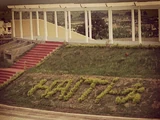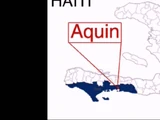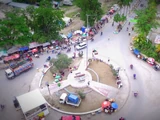Banane
Plantain (not "Plain" tain)
Musa paradisiaca
Cooked plantains are nutritionally very similar to a potato, calorie-wise, but contain more of certain vitamins and minerals. They're a rich source of fiber, vitamins A, C, and B-6, and the minerals magnesium and potassium. This hidden superfood warrants a trip your local market. Read on to learn why.
The starchy cooking banana, with its Bantu name, is part of the cultural baggage brought along with African slaves early in the European colonization of the West Indies. It I to be differentiated from the sweet banana, which is called figue or figue banane, a French usage which dates back to the 16th century, and which derives from a supposed resemblance to the fig (Ficus carica).
Plantains are much more important in the diet of the locals than are bananas. Throughout Haiti, their starchy fruits are a major food; even in the very dry areas, they are brought in from nearby moister districts.
Propogation is from suckers that shoot up around the stump of a plant that has been cut. These are transplanted into holes made with pick, hoe and crowbar. Within twelve months they begin to bear, continuing for four to five years. At high altitudes, fruiting does not commence before 16 to 18 months.
In dry regions such as Banane, the plantains usually are concentrated in the deeper and moister alluvial soils in the valley bottoms. Also, they are commonly planted on the steep shaded slopes above mountain streams. On river flood plains, they are the first crop above the normal high water level. Banane Bourrique serves as the principal coffee shade at high altitudes and often forms an understory to coffee shade trees in other areas.
There are many varieties which differ in size and shape, to name a few; Peau Blanc is 15 cm (6 in.) long by 7 cm (3 in.) in diameter and hexagonal; Kouyak is more slender and is pentagonal; Vincent is 30 to 35 cm (12 inches) long.
The stems are cut before the fruit is mature so that they are easy to transport and store. However, probably because of their low value in proportion to their weight, they are seldom taken more than 50 kilometers (30 miles) to market. Most often, they are prepared for eating when they are still hard and green (banane verte or rorote). Usually, they are simply peeled and boiled. Also, they may be roasted on a grill (banane boucané), sliced into disks which are squished thin and fried (banane pezé), or cut into longitudinal slices to be dried in the sun and pounded into flour. When they ripen, the flesh of the plantains becomes soft and yellow and it acquires a mildly sweet flavor. The ripe plantain (banane mure) is made ready for the table in the same manner as the unripe fruit, but it is not made into flour, and it may be smashed in a mortar to make tam tam.
Plantain skins are fed to the hogs and the stalks and leaves are fed to the cattle.
From the leaves, the locals fashion sleeping mats, crude raincoats, wrappings for food, and temporary pot covers. The stalks are lashed in a horizontal position to form an exterior wall covering in house gables.
All items (23)






























